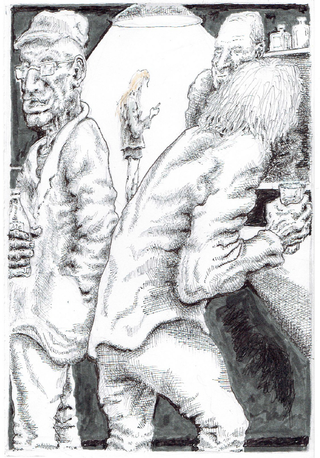Sex
Randomness in Mating Boosts Our Evolutionary Chances
An examination of sex and accident.
Posted March 31, 2021 Reviewed by Ekua Hagan

In Western societies, accident tends to get negative press as the domain of the unknown, a source of fear. Quirks of fate that cause automobile or airplane crashes, or the occurrence of fatal disease (see earlier in this series), are not something we feel too positive about.
But in some areas, and particularly among the odd bedfellows of romance and evolutionary science, humans accept and even celebrate what is impossible to know or predict, and cultivate the benefits chance confers.
Take falling in love. Many parts of the world still enforce what is usually the opposite of passion; non-random, arranged- and too-often-loveless marriages. Historically, life in the Medieval era and earlier was for most of the population too nasty, brutish, and short to sponsor luxuries such as waiting to fall in love with someone before getting married and having kids.
Theorists such as Denis de Rougemont have argued that the idea of chance encounters leading to romantic love, or eros, has been a relatively recent development, a spin-off of neo-Christian heresies such as that of the Cathars of southern France; later turbocharged in Western cultures (or so Karl Marx believed) by bourgeois individualism.
De Rougemont saw this form of love as destructive and anti-social. To eros he opposed a traditional version, which he termed agape: the stable, productive (if too often dispassionate) bond between man and wife whose apotheosis he found in the New Testament and the cult of the Virgin Mary.
But the evidence casts doubt on Christianity's, or the bourgeoisie's, role in the heart's dichotomy. Romantic love, and the random meetings it tends to be based upon, were the subject of art and philosophy before Christianity existed, and in places it held no sway. Bronze Age Vedic tradition spoke of Sringara, a fusion of sex and emotion, as one of the five classic forms of love. The pre-Christian Celtic legend of Tristan and Isolde describes the unpredicted and illicit passion between a king's nephew and the king's fiancée.
Persian poetry such as Fakhraddin Gorgani's 11th century Viz and Ramin was often built on the notion of "cute meets" and random love affairs. Pre-bourgeois novels, such as the 11th-century Tale of Genji in Japan and the 13th-century Roman de la Rose in France, were predicated on the idea of chance romantic encounters between a man and a woman. So were the lays of the medieval troubadours in Provence. The oldest folk tales, like the source stories of "Cinderella" and "Beauty and the Beast," also spoke of the mysteries and dangers of falling in love with the wrong person — or monster. Bourgeois individualism played no part in these narratives.
The concept of the random encounter leading, for good or ill, to a passionate relationship, no matter what the odds of its survival (see Romeo and Juliet, or Madame Bovary, or any number of General Hospital episodes) appears to be ingrained in the human psyche. In fact, the opposition between socially planned mating, and the oft-forbidden, disruptive couplings of romance, seems so basic as to suggest that the energy of human society depends to some extent on the creative conflict between the two.
It is tempting to speculate that this is because of the nature of sex itself. Sexual reproduction became dominant in human evolution precisely because it introduced an element of accident — of random chance — into the prosaic propagation of a given species. This was in opposition to binary fission, ie., splitting one's DNA in half to make an exact copy of oneself (or mitosis, which makes multiple copies), which was the original form of reproduction for life on Earth.
The usual wisdom is, having two more-or-less-randomly selected partners mate and reproduce ensures a much higher number of possible mutations, which by the law of averages means more will be available for survival purposes than among the mirror-image clones of a single gene pool.
But recent research has shown that while this idea might be true in a general sense, the specifics of how it works are more complex. All other things being equal — in a huge population living in conditions of plenty — asexual reproduction produces just as many useful mutations and without the costs of sex (such as STDs, or the energy burned to find a mate). A large percentage of Earth's living creatures, especially bacteria, have reproduced asexually and survived for billions of years.
But "all other things" are not equal. It turns out that in harsher environments, among smaller, more threatened populations, creatures that reproduce sexually will produce more and more varied mutations and will therefore adapt faster to difficult and changing environments. This is the hypothesis of the Red Queen, named for the character in Lewis Carroll's Alice's Adventures in Wonderland who must continually walk to stay in the same place; the idea being that creatures must continually come up with the maximum number of possible adaptations or a harsh environment will weed them out. A curious demonstration of this is provided by the tiny water flea known as daphnid, which reproduces asexually in favorable conditions, but switches to sexual reproduction when the season turns harsh.
And most creatures, including humans, live in a harsh environment. One crucial example of such harshness is disease, and in particular viruses. Viruses, such as the SARS COVID-19 virus — as many of us have learned, to our cost, in the recent pandemic — propagate by creating protein "keys" that allow them to unlock a host cell, invade it, and hijack the host's genome to create more viruses. Historically, our cells have fought back using mutations that alter their protein "locks" — the way we change passwords on internet accounts that have been hacked — so that whatever keys the virus currently uses can no longer be employed to break into the membrane and hijack the host.
It is here that sex comes into its own. Random sexual reproduction not only produces more mutations but allows each surviving generation to hang on to both useful mutations and mutations that are currently useless. The difference is crucial, in that the resulting "library" of leftover "useless" mutations contains huge amounts of genetic information which will be necessary to invent new locks to foil viruses. In this somewhat indirect way, sexual reproduction ensures the survival of a species that might well die out if it reproduced asexually.
How this dynamic at the level of our cells, or of evolutionary history, might have affected the romantic and sexual mores of modern humans remains an open question.




